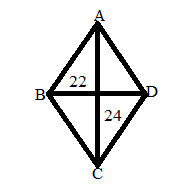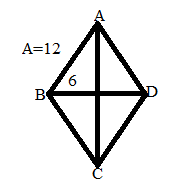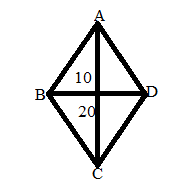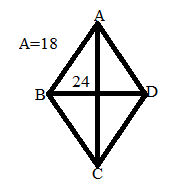Students must remember that the lengths of the rhombus are the same. The lengths of the diagonals in a rhombus are different and bisect each other at 90 degrees. With the help of the theorem, we can prove that the area of a rhombus is equal to half of the product of its diagonals. If you understand the theorem you can solve any type of question on the area of a rhombus.
The Area of a Rhombus is Equal to Half the Product of its Diagonals – Theorem
Question:
Prove that the area of the rhombus is equal to half of the product of its diagonals?
Given,
ABCD is a rhombus whose diagonals are AC and BD the diagonals intersect at O.
Proof:

Area of ABCD = 1/2 AC × BD
Area of ∆CDB = 1/2 × base × altitude [ BD perpendicular to AC because diagonals of a rhombus are perpendicular to each other]
= ½ × BD × CO……. equation 1
Area of ∆ABD = 1/2 × base × altitude
= ½ × BD × AO…… equation 2
Area of ∆CDB + area of ∆ABD
= ½ × BD × (CO + AO) [ by adding above two equations]
Area of rhombus ABCD = ½ × AC × BD [ by adding axiom for the area]
Hence proved.
Area of a Rhombus Examples
Example 1.
Find the area of the rhombus whose diagonals are 22cm and 24cm
Solution:
Given that

Diagonal d1 = 22cm
Diagonal d2 = 24cm
We know that
Area of rhombus = 1/2 × d1 × d2
Area of rhombus = ½ × 22cm × 24cm
= ½ × 528cm
= 264cm²
Example 2.
The area of the rhombus is 12 square cm and the diagonal is 6cm. Find the other diagonal.
Solution:
Given that

Area of rhombus = 12cm
Diagonal d1 = 6cm
We know that area of rhombus = ½ × d1 × d2
12 square cm = ½ × 6cm × d2
12 square cm = 3d2cm
12/3 square cm = d2cm
d2 = 4cm
Example 3.
Find the area of the rhombus whose diagonals are 10cm and 20cm.
Solution:
Given that

Diagonal d1 = 10cm
Diagonal d2 = 20cm
We know that
Area of rhombus = 1/2 × d1 × d2
Area of rhombus = ½ × 10cm × 20cm
= ½ × 200cm²
= 100cm²
Example 4.
The area of the rhombus is 6 square cm and the diagonal is 16cm. Find the other diagonal.
Solution:
Given that

Area of rhombus = 6 square cm
Diagonal d1 = 16cm
We know that area of rhombus = ½ × d1 × d2
6 square cm = ½ × 16cm× d2
6square cm = 8d2cm
6square cm/8 cm = d2cm
d2 = 3/4cm
Example 5.
The area of the rhombus is 18 square cm and the diagonal is 24cm. Find the other diagonal.
Solution:
Given that

Area of rhombus = 18 square cm
Diagonal d2 = 24cm
We know that area of rhombus = ½ × d1 × d2
18 square cm = ½ × d1 × 24cm
18 square cm = 24d1cm
18 square cm/24 cm = d2
d2 = 3/2 cm.
FAQs on The Area of a Rhombus is Equal to Half the Product of its Diagonals
1. Is the area of a rhombus equal to half the product of the diagonals?
The area of a rhombus is equal to half the product of the lengths of the diagonals. It is calculated using the diagonals of the rhombus.
A = 1/2 × d1 × d2
2. Does the diagonals of a rhombus bisect its area?
A rhombus is a parallelogram, opposite angles are congruent. One property unique to the rhombus is that in any rhombus, the diagonals will bisect the interior angles.
3. Is the area of a rhombus half the area of a rectangle?
Area of a rhombus = 1/2 x d1 x d2 where d1 and d2 are the diagonals of the rhombus. The length and breadth of the rectangle contained by the diagonals of the rhombus are d1 and d2 respectively. Therefore, the area of the rhombus is equal to half of the area of the rhombus.